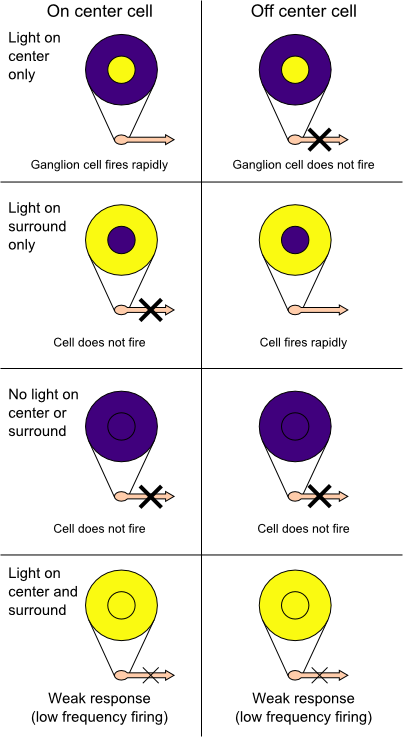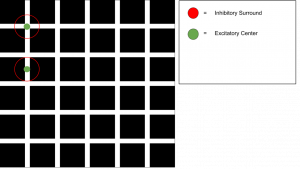Light and Eyeballs
89 Center-Surround Antagonism in Receptive Fields
Learning Objectives
Know what the center-surround receptive field is.
Be able to describe the differences between an ON-center and OFF-center receptive field.
Know what types of retinal cells have the center-surround receptive fields.
A visual receptive field is defined as the region of visual space in which a change in lightness or color will cause a change in the neuron’s firing rate. Almost all receptive fields have structure—different changes in different parts of the receptive field will have different effects on the neuron’s response.
The retinal ganglion cells have receptive fields that have a very basic organization, which resembles two concentric circles. This concentric receptive field structure is usually known as center-surround organization. On-center retinal ganglion cells respond to light spots surrounded by dark backgrounds like a star in a dark sky. If light falls on the entire receptive field, and not just the center, the cell will not increase its firing rate above baseline. Off-center retinal ganglion cells respond to dark spots surrounded by light backgrounds like a fly in a bright sky.
A key function of this receptive field structure is that neurons only respond to edges and small features. When center and surround are balanced, the RGC (retinal ganglion cell) will not change its firing rate in response to uniform illumination.

These receptive fields with center-surround antagonism are created by lateral inhibition, which happens as signals from photoreceptors are converging onto the ganglion cells. There are four basic types of lateral inhibition:
- Transient response with an excitatory center and inhibitory surrounding, or a shorter response in the retinal ganglion cells (RGC) with a receptive field that has a high firing rate in the center and low firing rate in the surrounding part of the receptive field.
- Transient response with an inhibitory center and excitatory surrounding, or a shorter response in the RGC with a receptive field that has a low firing rate in the center and high firing rate in the surrounding part of the receptive field.
- Sustained response with an excitatory center and inhibitory surrounding, or a longer response in the RGC with a receptive field that has a high firing rate in the center and low firing rate in the surrounding part of the receptive field.
- Sustained response with an inhibitory center and excitatory surrounding, or a longer response in the RGC with a receptive field that has a low firing rate in the center and high firing rate in the surrounding part of the receptive field.
Lateral inhibition has often been used to explain Mach bands, or the illusion that light and dark lines exist adjacent to sudden changes in brightness, and the gray dots that appear between intersections in the Hermann grid illusion (Fig.8.11.2). However, there are holes in this explanation — see this explanation from Peter Schiller’s lab at MIT.

CC LICENSED CONTENT, SHARED PREVIOUSLY
Cheryl Olman PSY 3031 Detailed Outline
Provided by: University of Minnesota
Download for free at http://vision.psych.umn.edu/users/caolman/courses/PSY3031/
License of original source: CC Attribution 4.0Scholarpedia, “Receptive field” by Dr. Jose-Manuel Alonso & Dr. Yao Chen, SUNY State College of Optometry
URL: http://www.scholarpedia.org/article/Receptive_field
License: CC BY-NC-SA 3.0

